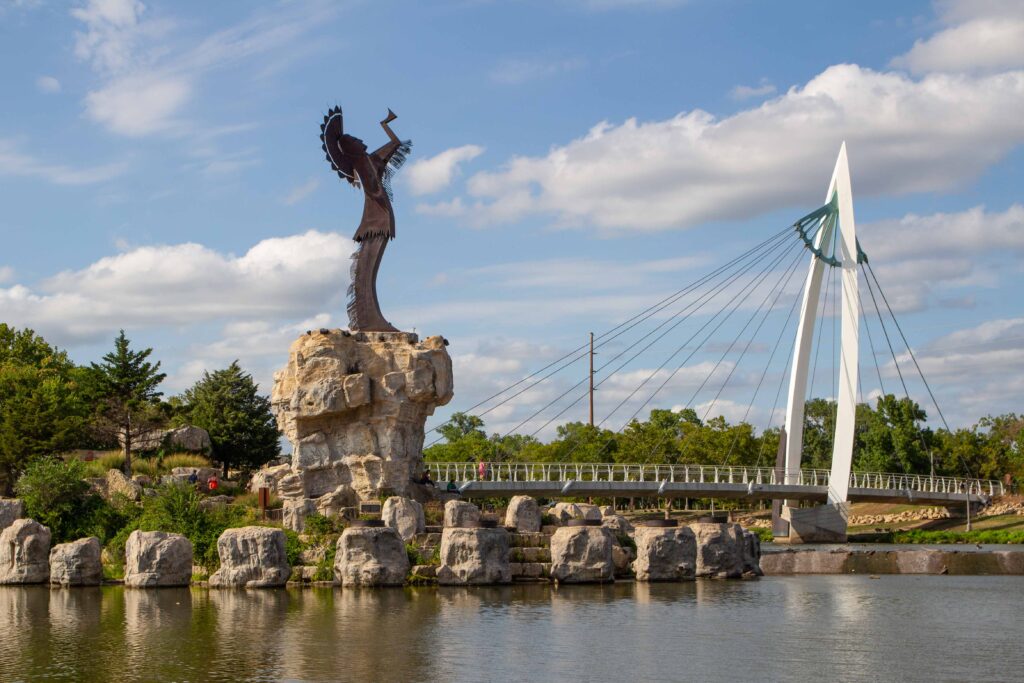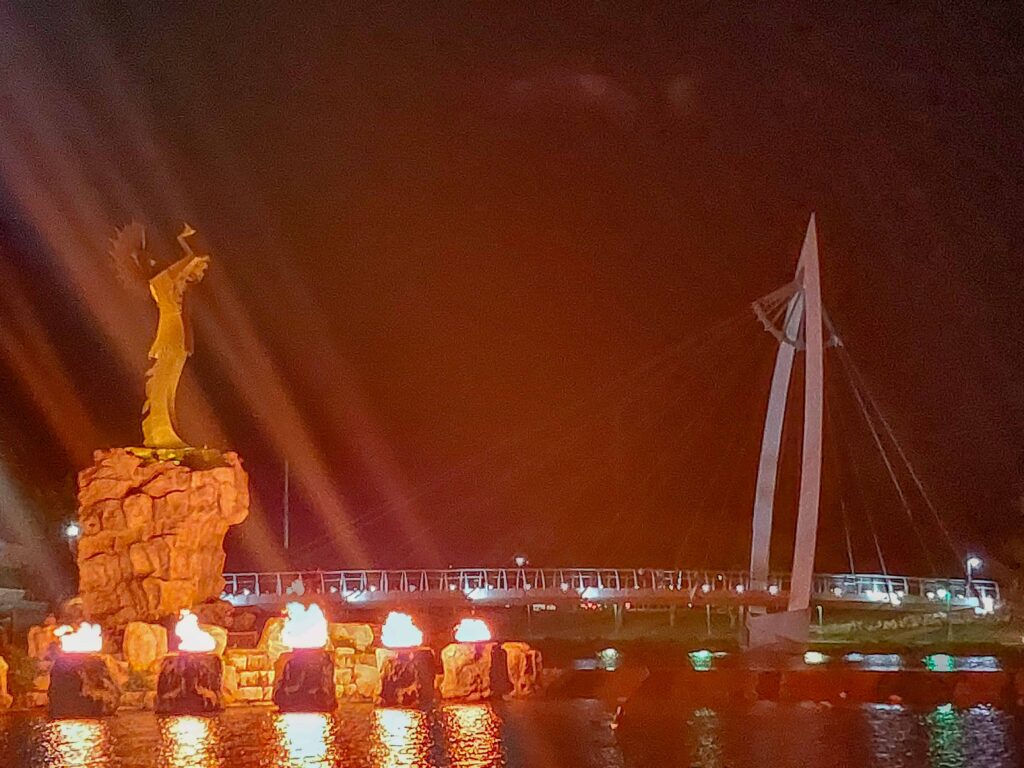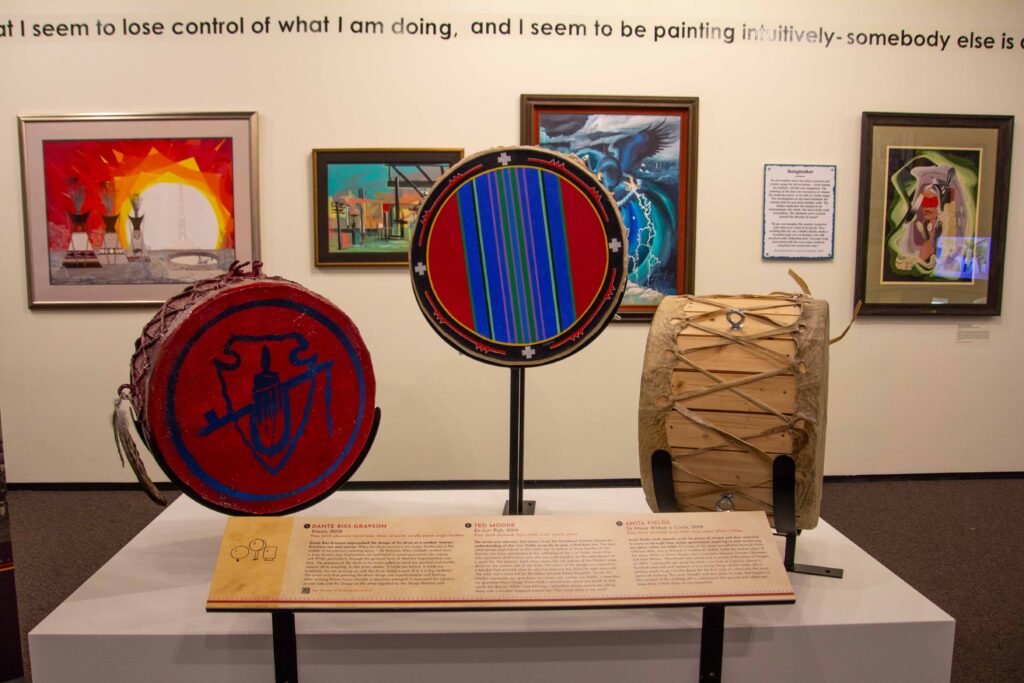At the confluence of the Arkansas and Little Arkansas Rivers in downtown Wichita, Kansas, the 44-foot awe-inspiring Keeper of the Plains sculpture stands with arms stretched upward to the Great Spirit. Even more imposing atop a 30-foot rock promontory, the Cor-Ten steel sculpture has become the iconic symbol of Wichita.
Nearby, the Mid-America All-Indian Center teaches about Indian culture and showcases American Indian artists.
Native American artist Blackbear Bosin created and donated the sculpture to the city in 1974. In 2006, the city raised the sculpture up onto the rock and created a plaza around it. The sculpture is a reminder of the Plains Indians who lived on the land in the past. When we were planning our Wichita trip, the folks from Visit Wichita suggested we see the Keeper of the Plains during the day and again at night. We’re glad we took their advice.
Keeper of the Plains in the Daylight

The entire plaza area around the Keeper of the Plains impressed us. We crossed a bridge, designed to resemble a bow and arrows, to reach the sculpture area. Being there in the daytime gave us the opportunity to read the many informational placards about the Plains Indians. We learned about their ceremonies, weapons, and storytelling. We learned about the Circle of Life. The four quadrants of the circle symbolize the four seasons, four directions, four times of the day, and the four sacred elements.
The four sacred elements are all represented at the Keeper of the Plains: Earth, wind, water, and fire. Earth, wind, and water are present all day, every day. However, the fire appears only after dusk, when conditions permit.
Keeper of the Plains in the Evening

The Keeper of the Plains sculpture impressed us during the day, but at night, even more so with fire around it. When the weather, wind, and river level cooperate, public works staff ignite the “Ring of Fire.” The Ring of Fire burns for 15 minutes.
Mid-America All-Indian Center
We learned more about the Keeper of the Plains artist Blackbear Bosin at the Mid-America All-Indian Center. The museum is located in the same area as the sculpture and contains more of Bosin’s art, as well as the art of other American Indian artists.
During our visit, a special exhibit focused on drums. We learned that the drum is the heartbeat of the powwow, symbolizes the heartbeat of Mother Earth, and is often a form of prayer. In fact, a powwow drum is blessed, and only certain people in the powwow are allowed to play it.

If You Go…
The Keeper of the Plains is located at 339 Veterans Parkway in Wichita, Kansas. When conditions permit, the Ring of Fire is lit from 9:00 to 9:15 in the spring and summer. In the winter, it’s lit from 7:00 to 7:15.
The Mid-America All-Indian Center is located at 650 N Seneca Street, in Wichita, Kansas. Check the museum’s website for hours and admission.
Other articles in this issue of Midwest Wanderer Explores…
Exploring the Kansas Gunsmoke Trail in Wichita
Exploring the Kansas Gunsmoke Trail in Dodge City
Exploring the Kansas Gunsmoke Trail in Hays
Exploring the Kansas Gunsmoke Trail in Abilene
Wild West Wichita Comes Alive at Old Cowtown Museum
Time Travel at the Wichita-Sedgwick County Historical Museum
Boot Hill Museum: Discover the Wild West Legacy
Home of Stone: The Mueller-Schmidt House—A Living Heritage
Boot Hill Distillery: Soil to Sip in a Historical Location
Historic Fort Hays: Tracing the Footsteps of Frontier Defenders
Cowtown to Carousels: Explore the Dickinson County Heritage Center
